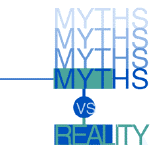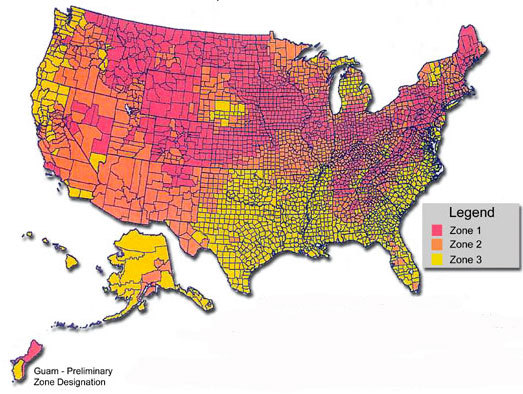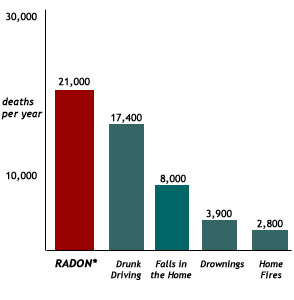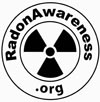Radon Myths
Radon myths can be very dangerous. What have you been told?

MYTH:
I'm safe because I don't spend much time in my basement.FACT:
If your furnace or duct runs are located in your basement or crawlspace, anytime the furnace fan runs for either heat or air conditioning, the radon level on the first floor is often the same as it is in the basement or crawlspace. Staying out of the basement doesn’t matter if your furnace fan is running even occasionally.
 MYTH:
MYTH:
Radon is naturally occurring so it must be safe.FACT:
Radon IS naturally occurring and so are earthquakes, tornadoes, floods, hurricanes, tsunamis, lightning, volcanoes, avalanches and mudslides. On average, radon kills more people every year than all of those combined. Dirt is natural too, but you don't want to be under six feet of it.MYTH:
I already have a radon monitor in my home and it says I'm safe.
FACT:
Some people mistakenly think that carbon monoxide monitors or smoke detectors measure radon. Every home should have both but they can't detect radon. On average, residential fires kill 2,800 Americans every year. Carbon monoxide deaths in the home average 235 per year. Radon, still at 21,000 deaths a year.MYTH:
My home is new so I can’t have a radon problem. FACT:
FACT:
Many newer homes have higher radon levels than older ones because they now design homes to have better porosity in the soil around the house. This is done for moisture control but the result is easier flow for the radon gas to be drawn in. It doesn’t matter how old your home is, if there is the right amount of radium in the soil, you may have a serious problem.MYTH:
My neighbors home tested fine so I must be safe.FACT:
You can never rely on your neighbor’s radon results as a comparison to yours. Even identical homes in the same development, next door to each other, built at the same time by the same builder can be 100 times higher or lower than your house. There can even be a huge difference in just one side of a duplex or attached townhome. That is why every residence in America needs to be tested.MYTH:
I live in an area that doesn’t have any radon problems.
FACT:
Some areas of the country have been shown to have lower radon levels on average than others, but serious problems have been found in every State and in many areas that used to be considered low risk.
MYTH:
My home is a ________________ (walk-out, ranch, 2 story, split level, slab on grade, etc.) so I won’t have a problem.FACT:
The style of the home has very little to do with radon entry. All structures have negative pressures in the lower half of the building no matter how they are built or how they are designed. No particular style of home is more or less likely to have a radon problem including homes of all types: old homes, new homes, drafty homes, insulated homes, homes with basements, and homes without basements.The only way to know you have a problem, is to test.
MYTH:
Low-level exposure to radon is harmless.
FACT:
There is no level of exposure to radiation that is harmless. Human exposure to radiation should be avoided whenever possible. The U.S. Environmental Protection Agency (EPA) and every other health agency state that any home with radon levels of 4 pCi/L or greater should be fixed. Period. If your home is between 2 and 4 pCi/L, you should seriously consider fixing it.MYTH:
Homes with radon problems can’t be fixed.FACT:
Hundreds of thousands of homeowners have already had their radon problems fixed and more and more families are doing it every day. Any home can be fixed and the higher the radon level, the faster you should have it fixed. MYTH:
MYTH:
I’ve lived in my home for so long, it doesn’t make sense to take action now.FACT:
If you discovered that your family car had been recalled because the wheels could fall off at anytime, would you keep driving it? Of course not. You will reduce your risk of cancer as soon as you reduce your radon levels, even if you’ve lived with a radon problem for a long time. Reducing your radon levels now can help to greatly reduce the effects from past exposure.MYTH:
If radon is such a big deal, why aren't our government health officials doing something about it?
FACT:
They’ve already spent millions and millions of dollars trying. They’re not sure what to do next with the budget they have. Just look at all of the publications, brochures, posters, videos, radio and T.V. commercials they’ve already produced at a huge expense to us, the tax payers. No one is listening because of "The Basic Principals Of Advertising” which state that unless the message is repeated over and over and over again, no one will pay attention. A limited budget doesn’t buy advertising during the Super Bowl. Another reason is that our country is based on old English law, “A Man’s Home Is His Castle”. You can live in a home with as much radon as you’d like, the government isn’t going to force you to test or fix your home. That’s up to you.MYTH:
If radon is such a big deal, why don’t we see or hear more about it?FACT:
The media reports the news and radon isn’t news anymore. If a family of four dies in a house fire, it is indeed very sad and will be mentioned at the top of the broadcast, but they can’t start every news show by saying “And this just in…Over 50 people died today after being exposed to radon” (21,000 / 365 days = 57.53 people a day in America). Radon isn’t new any more. We’re supposed to already know.MYTH:
Everything causes cancer so why worry. FACT:
FACT:
Not everything causes cancer, but it seems like that sometimes on the news reports. Cooking a hamburger on the grill everyday for an entire lifetime apparently causes cancer but statistically only effects about one person a year. Same with cell phones, sugar substitutes and all the other cancer scares we hear about. Unfortunately, all of those less significant risks distract us from the major causes of cancer like smoking and radon. 12% of ALL cancer deaths have been linked to radon and not just one person but over 21,000 Americans die every year from radon. In other words, it doesn't make much sense to worry about the splinter in your finger when there's a tree about to fall on you. Quit smoking, fix your radon problem, then maybe go ahead and relax, call a friend, fire up the grill and enjoy a diet soda.MYTH:
If it’s not one thing, it’s another. FACT:
FACT:
True, we’re all going to die from something, but most people would prefer old age rather than cancer. Some people die while doing something they enjoy like skydiving, swimming, grilling hamburgers, etc. They weigh the risks and decide that the risks are worth the enjoyment, but nobody gets enjoyment from radon. It’s a huge risk with no benefit.MYTH:
Do-It-Yourself radon test kits are not accurate.FACT:
If you follow the instructions, D.I.Y. test kits are just as accurate as the extremely expensive professional radon monitors. If you are testing your own home and not in the process of a real estate transfer, the D.I.Y. test kits are recommended.MYTH:
Long-term test kits are more accurate than short-term test kits.FACT:
They are both as accurate and each will show you what the average radon concentration was during the time period tested. However, radon levels do vary dependent upon weather conditions and other factors. Long term testing will show the average results over a longer period of time and will average all of those changing conditions together for your final result. Radon levels within the home are usually lower in the spring and fall, while being higher in the winter and summer. Partially because our houses are more closed up, but mainly because the pressures within our houses that draw in the radon are greater whenever the temperature differences are more extreme. Although radon levels can vary widely throughout the year, short term tests are still recommended as the first step just in case your radon levels are extremely high. If you'd like to run a follow up test and average the two over different seasons, or take a longer test for a longer average, that's up to you, but results from short term testing has been shown to have the same bearing on mitigation decisions 94% of the time.MYTH:
If radon is so important, someone, somewhere will remind me to test later.
FACT:
Some things are so important that we shouldn’t need to be reminded. If you haven’t tested, you need to do it as soon as possible. Your health and your family’s health are important right now. Radon is a major cause of cancer but is also suspected in contributing to a variety of other illnesses including Leukemia, Multiple Sclerosis, Alzheimers and Parkinson's Disease. Why take a chance? Please don't wait.MYTH:
I’m sure my friends, neighbors and loved ones already know about radon so I won’t worry about them.
FACT:
The majority of families in the United States still don’t know how serious radon is. They’ve heard about it, seen some news about it and still don’t know the facts. Please help spread the word by telling everyone you can about radon. Knowledge is power and with knowledge comes responsibility. Please, make sure they know as much as you do.Protecting Your Family Is Easy... Learn the Facts, Test your Home.
If a Problem is Found, Fix It.
This site is made possible by visitors like you.
Thank you and we appreciate your support!
This site is made possible by visitors like you.
Thank you and we appreciate your support!
